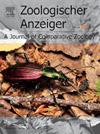日本壁虎属(鳞目:壁虎科)种间的自然杂交:交配前和交配后分离的作用
IF 1.5
3区 生物学
Q2 ZOOLOGY
引用次数: 0
摘要
在日本8种壁虎属植物中,有4对不同频率的自然杂交。最近的一项行为研究表明,雄性的求偶叫声对某些种类的壁虎来说是一种提前交配的隔离;然而,其他的缺乏物种特有的叫声,这导致杂交。目前还没有进行全面的研究来确定这一群体中隔离障碍发展的一般模式。利用微卫星标记和同工酶数据对7个品种的8对杂交情况进行了群体遗传分析。然后,我们在系统发育框架中研究了随着遗传距离的增加,杂种频率和F1杂种占杂种总数的比例的变化。通过统计建模评估了求偶叫声类型作为杂交存在与否的决定因素的贡献。遗传分析的结果显示,除了先前报道的物种对外,三种物种的两对杂交,每对都有一种特定的叫声。统计分析表明,种间杂交频率与遗传距离呈负相关,F1杂交比例随遗传距离的增加而增加。结果表明,该群体在遗传分化的情况下逐渐发展为交配后分离。叫声类型对杂交存在与否的贡献没有得到充分的支持,部分原因是其中一个物种的杂交表现出物种特有的叫声。讨论了具有物种特异性叫声的物种之间异常杂交的可能原因。本文章由计算机程序翻译,如有差异,请以英文原文为准。
Natural hybridization among species of the genus Gekko (Squamata: Gekkonidae) in Japan: the roles of pre- and postmating isolation
Among the eight Japanese species of the genus Gekko, natural hybridization was reported in four pairs at various frequencies. A recent behavioral study suggested that the species-specific courtship calls of the males act as premating isolation for some species of these geckos; however, others lack species-specific calls, which results in hybridizations. No comprehensive study has been conducted to identify a general pattern in the development of isolating barriers in this group. We examined the hybridization status between eight pairs of seven species using population genetic analyses based on microsatellite markers and allozyme data. We then examined the changes in the frequency of hybrids and the proportion of F1 hybrids against the total number of hybrids along with increasing genetic distances in a phylogenetic framework. The contribution of the courtship call type as a determinant of the presence/absence of hybridization was evaluated by statistical modeling. The results of the genetic analyses revealed hybridizations between two pairs of three species, each having a species-specific call, in addition to previously reported species pairs. Statistical analyses indicated that the frequency of hybrids between species was negatively correlated with genetic distance, and the proportion of F1 hybrids increased with genetic distance. The results suggest the progressive development of postmating isolation with genetic divergence in this group. The contribution of call type to the presence/absence of hybridization was not fully supported, in part, because of the hybridizations of one of the species exhibiting species-specific calls. A possible reason for the exceptional hybridizations between the species with species-specific calls is discussed.
求助全文
通过发布文献求助,成功后即可免费获取论文全文。
去求助
来源期刊

Zoologischer Anzeiger
生物-动物学
CiteScore
2.80
自引率
7.10%
发文量
75
审稿时长
>12 weeks
期刊介绍:
Zoologischer Anzeiger - A Journal of Comparative Zoology is devoted to comparative zoology with a special emphasis on morphology, systematics, biogeography, and evolutionary biology targeting all metazoans, both modern and extinct. We also consider taxonomic submissions addressing a broader systematic and/or evolutionary context. The overall aim of the journal is to contribute to our understanding of the organismic world from an evolutionary perspective.
The journal Zoologischer Anzeiger invites suggestions for special issues. Interested parties may contact one of the editors.
 求助内容:
求助内容: 应助结果提醒方式:
应助结果提醒方式:


